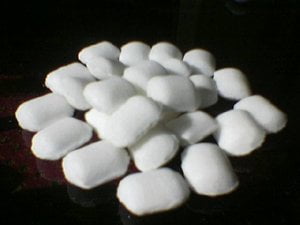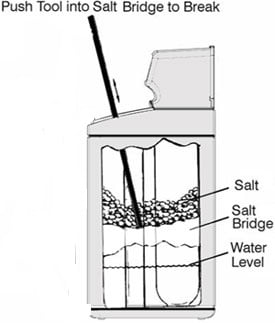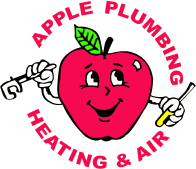
As we wrote in a previous blog, water softeners use salt to create a brine. That brine rinses off the hardness (calcium) from the resin inside the softener. It then recharges it with more sodium to continue removing hardness from the water. So, let’s look at the salt needed to complete this act. Now, there are two different types of salt- solar salt (left) and pellet salt (below)- that can both be entered into the brine tank of a water softener. Solar salt looks likes the salt that used to de-ice roads, or just much larger versions of grains of table salt. Pellet salt looks like packaging peanuts. Both are still salt so they both create the same effective brine mixture to rinse off the resin. But, as professionals, we recommend using solar salt- not because it is better but because of an unfortunate occurrence that is all too common with pellets.
One thing about solar salt is that it is smooth in texture and dissolves into water through erosion. Pellets, on the other hand, are porous and the dissolving process is a lot more like melting than erosion. The pellets get soaked by the water in the brine tank and soften before they dissolve. When the brine water is removed from the tank the pellets harden and meld together. This is where it becomes a problem.
Brine tanks always fill to the same water level to create the brine mixture. The water dissolves the salt, and as it does the salt above falls down to the bottom of the tank. However, in some instances the water will touch just the very bottom of a layer of pellets and will then harden them together to form one long sheet of hardened salt (pictured below in example illustration). This can create what we call a bridge and prevent the pellets from falling into the water. Now the softener is being rinsed with just water and not brine so the resin stays full and the softener stops working.

This is generally not caught by homeowners until they notice they haven’t used salt in 6 months and the result is that Apple has to break up and remove the harden pellets or just replace the entire brine tank. It doesn’t happen to every system using pellets, but for the unfortunate few it is a costly problem.
One thing to note is that some pellets come premixed with an iron removal substance and solar salt does not. But for systems that need a low level iron removing agent you can add a product called “Iron Out” in addition to solar salt to your brine tank.
For those on a low sodium diet, fear not, generally the amount of sodium added to your water is very low- generally less than 12.5 milligrams per 8 oz. glass of water; much lower than the Food and Drug Administration’s standard for “very low sodium”, which is less than 35mg of sodium per serving. A “low sodium diet” according to the USDA is less than 1500mg/day, or 120 glasses of softened water! But if sodium is just a deal breaker, there is a company that makes pellets of potassium-chloride that can be used in place of salt. But beware, those pellets can bridge!
Solar salt, potassium chloride, and iron out can all be purchased from us here at Apple.
Same Day Emergency Service available! Call us at 410-840-8118 or fill in the form.






